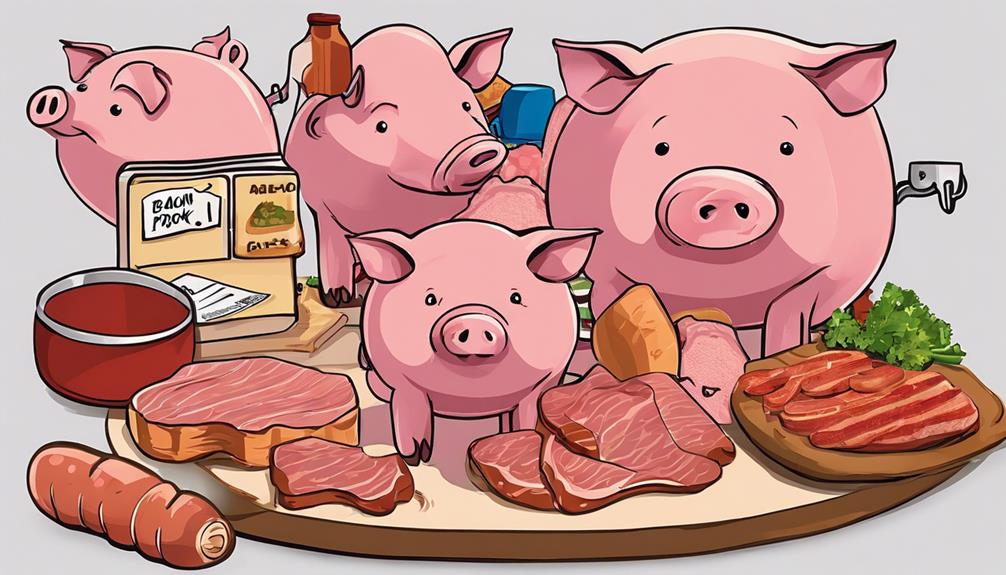Why Are Pig Products Economically Valuable?
Pig products are like hidden gems in the world of agriculture, holding a value that goes beyond what meets the eye. From succulent pork chops to versatile pig skin used in various industries, the economic significance of these products runs deep.
But what truly makes pig products stand out in the market goes beyond just taste or utility. There's a complex interplay of factors that contribute to their economic worth, shaping industries and markets in ways that might surprise you.
Global Demand for Pork
Global demand for pork has been steadily increasing over the past decade due to its versatility and affordability in various cuisines worldwide. Pork consumption trends show a consistent rise as more people incorporate pork into their diets. This increase can be attributed to the diverse ways pork can be prepared, making it a popular choice among consumers.
The pork industry is seizing growth opportunities by adapting to changing consumer preferences and expanding into new markets. With the rise in demand for pork products, there's a need for innovation and sustainability within the industry to meet these needs effectively. By exploring new avenues for marketing and distribution, the pork industry can capitalize on this growing demand.
As pork consumption trends continue to climb, the pork industry must also focus on enhancing production efficiency to meet these increasing demands sustainably. This involves investing in technology and practices that improve productivity while maintaining high standards of animal welfare and environmental responsibility. By doing so, the pork industry can ensure long-term growth and profitability while meeting the needs of consumers worldwide.
Diverse Uses of Pig Skin
The versatile pig skin finds a myriad of applications in various industries, showcasing its importance beyond just meat production. In the leather industry, pig skin, also known as pig leather or pork leather, is highly valued for its unique properties. Pig skin is thinner and more flexible than cowhide, making it ideal for manufacturing high-quality leather goods such as gloves, shoes, and garments. Its fine grain and natural elasticity contribute to durable and comfortable products that are in demand worldwide.
Additionally, pig skin is utilized in cosmetic applications due to its collagen-rich composition. Collagen, a protein found in connective tissues like skin, plays a vital role in maintaining skin elasticity and hydration. Pig skin-derived collagen is used in various cosmetic products like moisturizers, anti-aging creams, and serums to promote skin health and youthful appearance. The collagen extracted from pig skin is biocompatible with human skin, making it a popular choice in the cosmetics industry.
Profitability of Pig Farming
Pig farming presents a lucrative opportunity for those looking to capitalize on the economic value of pig products. If you're considering entering the pig farming industry, here are some key points to keep in mind:
- Cost Efficiency: To ensure profitability, focus on cost efficiency by optimizing feed quality, managing waste effectively, and investing in modern farming technologies.
- Market Trends: Stay informed about market trends to make strategic decisions regarding pricing, production levels, and product diversification. Adapting to consumer preferences can help maximize profits.
- Profit Margins: Understanding profit margins is crucial. Monitor expenses closely, explore value-adding opportunities such as organic certification or specialty products, and negotiate fair prices with suppliers and buyers.
- Breeding Strategies: Implement effective breeding strategies to enhance productivity and quality. Select breeding stock carefully, consider genetic traits that align with market demands, and prioritize animal welfare for sustainable long-term success.
Economic Impact of Pig By-products
Maximizing the economic potential of pig by-products requires strategic utilization and value-added processing techniques. Pig by-products play a significant role in the economy due to their diverse applications and contributions to various industries. Market trends indicate a growing demand for pig by-products in sectors such as pharmaceuticals, cosmetics, pet food, and biofuels. This demand creates opportunities for economic benefits through the efficient utilization of these by-products.
Effective waste management is crucial for maximizing the economic value of pig by-products. By implementing sustainable waste management practices, such as recycling, composting, and conversion to energy, pig farmers can reduce disposal costs and generate additional revenue streams. These practices not only provide economic benefits but also help minimize the environmental impact of pig farming.
Furthermore, the economic impact of pig by-products extends beyond the farm level. Value-added processing techniques, such as refining pig fat into high-value products like biodiesel or using pig skin for leather production, enhance the economic value of these by-products. Collaborating with industries that utilize pig by-products can create a more sustainable and economically viable supply chain.
Pig Meat Export Markets
To explore new avenues for economic growth in the pig industry, consider examining the dynamic landscape of pig meat export markets. When delving into pork industry trends and export market analysis, it's crucial to stay informed and adaptable to capitalize on opportunities.
Here are some key points to keep in mind:
- Market Diversification: Explore emerging markets for pig meat exports to mitigate risks associated with dependency on a single market. Diversification can help in maintaining a stable revenue stream despite fluctuations in specific markets.
- Quality Standards: Adhering to high-quality standards is essential to access premium markets and maintain a competitive edge. Consistent quality not only ensures customer satisfaction but also opens doors to lucrative export opportunities.
- Tariff Regulations: Stay updated on changing tariff regulations and trade agreements that could impact pig meat exports. Understanding these regulations can help in strategizing market entry and pricing strategies effectively.
- Consumer Preferences: Analyze consumer preferences in different export markets to tailor products accordingly. Being responsive to varying tastes and preferences can enhance market penetration and customer loyalty.
Sustainability in Pig Production
How can the pig industry adapt to ensure sustainability in production practices? Sustainability in pig production is crucial for reducing the environmental impact and improving waste management. One way the industry can achieve this is by implementing efficient waste management systems. Proper waste management not only helps in reducing pollution but also allows for the recovery of valuable by-products such as biogas or fertilizer from pig waste.
Moreover, adopting environmentally friendly practices like utilizing renewable energy sources can significantly reduce the carbon footprint of pig farming. Implementing technologies such as solar panels or anaerobic digesters can help farms become more self-sufficient and sustainable in the long run.
Furthermore, promoting biodiversity and natural habitats within and around pig farms can enhance the ecosystem and reduce the overall environmental impact. Preserving natural habitats like wetlands or forests can provide additional benefits such as water filtration and wildlife conservation.
Value-added Pig Products

Enhancing the economic value of pig products can be achieved through innovative processing methods and product diversification. When it comes to adding value to pig products, staying updated with culinary trends and market opportunities is crucial. Here are some strategies to maximize the value of pig products:
- Creating Specialty Cuts: By offering unique pork cuts tailored to current culinary trends, such as heritage breeds or specific marbling preferences, you can cater to niche markets and command premium prices.
- Developing Ready-to-Eat Products: Convenience is key in today's fast-paced world. Developing ready-to-eat pig products like pre-marinated pork skewers or seasoned pulled pork can attract busy consumers looking for quick meal solutions.
- Exploring Organic and Natural Options: With the increasing demand for organic and natural foods, producing pig products free from antibiotics and hormones can open up lucrative market opportunities among health-conscious consumers.
- Collaborating with Local Chefs and Restaurants: Partnering with renowned chefs or local restaurants to create signature pig product dishes can't only increase product visibility but also leverage their customer base for greater market reach.
Technological Innovations in Pig Industry
Maximizing the economic value of pig products can also be significantly influenced by the integration of advanced technological innovations in the pig industry. Genetic engineering plays a crucial role in enhancing desirable traits in pigs. Through genetic engineering techniques, such as selective breeding and gene editing, pigs can be developed to exhibit traits like improved growth rates, disease resistance, and meat quality. This not only increases the efficiency of pork production but also ensures a higher quality end product that meets consumer demands.
Precision farming is another key technological innovation in the pig industry that has revolutionized how pigs are raised. By utilizing precision farming techniques, such as sensor technology, data analytics, and automated systems, pig farmers can monitor and manage their herds more effectively. This leads to optimized feed utilization, reduced environmental impact, and overall improved animal welfare. The ability to precisely control factors like feeding schedules, environmental conditions, and health monitoring results in healthier pigs and higher productivity levels.
Frequently Asked Questions
How Do Cultural and Religious Beliefs Impact the Demand for Pork Globally?
Cultural preferences and religious beliefs heavily influence global demand for pork. Consumer behavior shifts based on these factors, affecting the market for pig products.
Choices surrounding food consumption reflect deep-rooted traditions and customs, impacting the demand for pork in various regions. Understanding these cultural dynamics is crucial for businesses to effectively cater to diverse consumer preferences and maintain a strong market presence for pig products.
Are There Any Unique or Unexpected Uses for Pig Skin That Contribute to Its Economic Value?
When it comes to pig skin, there are some surprising uses that add to its economic worth. Medical innovations have found pig skin to be valuable for skin grafts due to its similarity to human skin.
Additionally, the fashion industry has also embraced pig skin for making high-quality leather goods like bags and shoes. These diverse applications beyond food production contribute significantly to the economic value of pig skin.
How Do Fluctuations in Feed Prices and Production Costs Affect the Profitability of Pig Farming?
Fluctuations in feed prices and production costs can significantly impact the profitability of pig farming. When inflation drives up costs, it squeezes profit margins for pig farmers.
Market trends also play a crucial role, as shifts in consumer demand or global supply can affect prices. Staying informed and adapting to these changes is key to navigating the challenges of the pig farming industry and maintaining a profitable business.
What Are Some Hidden Economic Benefits of Pig By-Products That Are Often Overlooked?
When it comes to pig by-products, there are hidden economic benefits that often go unnoticed. Biomedical applications utilize materials sourced from pigs for various medical purposes.
Additionally, the leather industry finds opportunities in using pigskin for producing high-quality leather goods. These lesser-known aspects of pig by-products can contribute significantly to the economic value of pig farming operations.
How Do Trade Agreements and Political Factors Impact the Pig Meat Export Markets?
When it comes to pig meat export markets, trade agreements and political factors play a significant role in shaping the market dynamics.
Consumer preferences, export regulations, and supply chain management are also crucial in meeting global demand.
The economic impact of these factors can greatly influence the profitability and sustainability of the pig meat industry.
Conclusion
In conclusion, pig products are economically valuable due to the global demand for pork and diverse uses of pig skin. The profitability of pig farming and the economic impact of by-products also contribute to the industry's success. Additionally, pig meat export markets, sustainability in pig production, value-added products, and technological innovations play key roles in maintaining the sector's importance. With these factors in play, pig farming continues to be a lucrative and essential sector in the agricultural industry.
